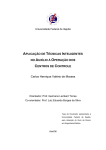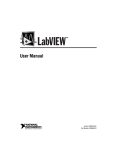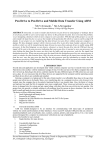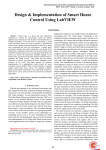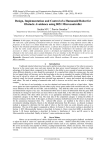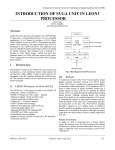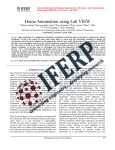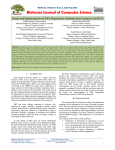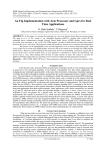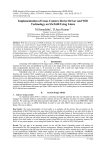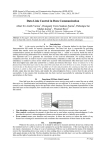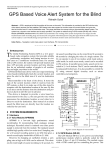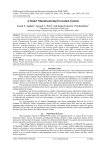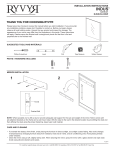Download Development of Distributed Mains Monitoring and Switching
Transcript
IOSR Journal of Electronics and Communication Engineering (IOSR-JECE) e-ISSN: 2278-2834,p- ISSN: 2278-8735.Volume 10, Issue 6, Ver. I (Nov - Dec .2015), PP 01-09 www.iosrjournals.org Development of Distributed Mains Monitoring and Switching System for Indus Complex Neeraj Chandnani1, A.M. Gupta2, Pravin Fatnani2, Preet Jain1 1 (Department of Electronics and Communication Engineering, Shri Vaishnav Institute of Technology and Science, Indore, India) 2 (Accelerator Control Section, Raja Ramanna Centre for Advanced Technology, Indore, India) Abstract: Indus Complex at Raja Ramanna Centre for Advanced Technology (RRCAT) has two synchrotron radiation sources, Indus-1 and Indus-2. Microtron is injector to both the machines which sends electron pulses to the Booster. A new, microcontroller based, distributed mains monitoring and switching system is developed for Indus complex. It facilitates remote monitoring and switching of AC power switches to various subsystems. It includes interfacing with power switches/Miniature Circuit Breakers (MCBs) of Indus machine subsystems. This work involves development of hardware, firmware for microcontroller, implementation of communication protocol; LabVIEW based server and client application. The developed system allows remote monitoring and switching of MCBs from main control room. Keywords: Microcontroller, LabVIEW, Protocol, MCB, Power I. Introduction In RRCAT, Indus complex is having many subsystems associated with Microtron, Booster, Indus-1 and Indus-2. During machine startup and shut down, operation crew needs to switch many MCBs and when machine operation is interrupted because of any fault these MCBs are needed to be checked as a procedure for debugging. If the status of all MCBs is made available in the main control room it will be helpful and will improve operation activity. To fulfill the requirement an AC power status monitoring and switching system has been planned. Fig.1 shows the block diagram of complete system. It consists of server, client and microcontroller based field modules interfaced with MCBs. Real time database storing facility is also provided for offline analysis. Server communicates to field modules over RS-485 network. Communication between server and client is implemented over Ethernet. The system senses line phases (R, Y, B) through optical fiber to provide physical as well as electrical isolation. A distributed AC mains power monitoring and switching system is developed which allows remote monitoring and controlling of power input to various subsystems. Indus complex is distributed over large area; there are so many subsystems whose input AC power status is to be checked for debugging. At present operation crew checks the status of various MCBs manually. It takes a lot of time to check for the various MCBs. So, a system is developed which provides the status of MCBs at one place, hence it saves time. II. Literature Survey The Literature survey is done to collect information about other systems available in market. One similar type of system developed by Starkstrom Company, UK, named as “MCB Trip Monitoring Module (MTMM)”[1]. Comparison between this system and developed system is shown in table 1. Table 1: Comparison between developed system and similar systems S.NO. 1 2 3 4 5 6 7 Developed System Modification is easy Firmware is developed in such a manner that it can be used for other applications as well Up-gradation and maintenance done in house High voltage isolation through fiber optics Low cost PC interface, data-logging implemented Monitoring and control both features implemented DOI: 10.9790/2834-10610109 MCB Trip Monitoring Module (MTMM) Modification is not possible Firmware is copyright Depends upon vendor Isolation through transformer only Costly than developed system Only local monitoring available by means of LEDs. Only monitoring available www.iosrjournals.org 1 | Page Development of Distributed Mains Monitoring and Switching System for Indus Complex Fig.1: Block diagram of complete system III. System Descriptions The system consists of microcontroller field modules, firmware for microcontroller, server and client application. 3.1 Microcontroller field module As shown in fig.2, addressable Microcontroller based field modules communicates with server. Eight bit DIP switch is used to set address of field modules and addresses are settable from 1 to 255. Auto module detection and registration feature is incorporated in the system. As the field modules connected on the RS485 network, server checks communication with field modules and registers address of it in server database and starts communication automatically. All connected Microcontroller modules are in listening mode therefore as command sent by server to a particular module then only addressed module sends response. The communication mode is half duplex, and single master type hence at a time only one field module communicates with server. In case if two modules addresses matched due to human mistake then server receives check-sum error and tries multiple times to get the response from the module and finally declares that address faulty and blocks communication with the particular address/addresses. Field module Inputs/Outputs details are as follows: DOI: 10.9790/2834-10610109 www.iosrjournals.org 2 | Page Development of Distributed Mains Monitoring and Switching System for Indus Complex Table 2: Microcontroller module I/O signal description Name of Signal R Y B ST1 ST2 ST3 RL1 RL2 RL3 Type of signal Input Input Input Input Input Input Output Output Output Description „R‟ Electrical Phase status „Y‟ Electrical Phase status „B‟ Electrical phase status Contact status of RL1 Contact status of RL2 Contact status of RL3 Potential free relay contact Potential free relay contact Potential free relay contact Fig.2: Schematic block diagram DOI: 10.9790/2834-10610109 www.iosrjournals.org 3 | Page Development of Distributed Mains Monitoring and Switching System for Indus Complex 3.2 Communication Protocol Communication between server PC and microcontroller field modules is done over RS-485 network using Modbus protocol. RS-485 communication interface is chosen for the development of the system because large number of subsystems is present in the Indus complex. As shown in comparison table 3, standard RS-485 transceiver supports 32 nodes on one physical network with the maximum length of the communication link 4000 feet. The number of nodes can be further increased by using RS485 repeaters. Any Microcontroller can be programmed and set-up to communicate on standard Modbus network using two types of serial transmission modes: (1) ASCII and (2) RTU. This system is developed using ASCII mode because of its advantage that it is easier for debugging if any problem occurs during communication. Table 3: Comparison between serial communication interfaces Specifications Communication Communication Mode RS-232 Peer to peer Simplex or full duplex Mode of Operation Total Number of Drivers and Receivers on One Line Maximum Cable Length Maximum Data Rate (40 feet - 4000 feet for RS-422/RS-485) Single-Ended 1 Driver 1 Receiver 50 feet (2500 pF) 160 Kbits/s (can be up to 1Mbit/s) RS-422 Peer to peer Simplex or half duplex or full duplex Differential 1 Driver 10 Receivers 4000 feet 10 Mbit/s RS-485 Multidrop Simplex or half duplex or full duplex Differential 32 Drivers 32 Receivers 4000 feet 10 Mbit/s Table 4: ASCII command frame FIELD CHAR LENGTH START 1 CHAR : ADDRESS 2 CHARS FUNCTION n CHARS DATA 2 CHARS LRC CHECK 2 CHARS END 2 CHARS CRLF Function codes of Modbus protocol [2] implemented for P89C51RD2 microcontroller are shown in table 5. Table 5: Function codes Function Code 01 02 03 05 06 Function Code Name Read Coil Status Read Input Status Read Holding Registers Force Single Coil Diagnostic Sub function Working of Function Code It reads all ports (P0, P1, P2, P3) of microcontroller bit wise. It reads all ports of microcontroller byte wise. It gives the information about the SFR of microcontroller. It writes the user defined hex value to the desired port of microcontroller. It echoes backs the transmitted frame in response. Exception Codes of Modbus protocol [2] implemented for P89C51RD2 microcontroller are shown in table 6: Table 6: Exception codes Exception Code 01 02 03 Exception Code Name Illegal Function Illegal data address Illegal data value Working of Exception Code Function Code not supported. Address not available/wrong address. Data value out of range/wrong data value. 3.3 Server Application Server application running at server PC polls the Microcontroller field modules one by one and records the status of AC power MCBs in the database which can be referred for offline analysis. It provides information about communication link between server PC and microcontroller field modules, status of AC power MCBs in terms of electrical phases (R, Y, and B), module enable/disable, response indication, checksum, response string length, poling count, port number and baud rate at which the serial communication is established between server PC and field modules. DOI: 10.9790/2834-10610109 www.iosrjournals.org 4 | Page Development of Distributed Mains Monitoring and Switching System for Indus Complex Fig.3: Server Application front panel GUI Fig.4: Microcontroller firmware flow chart DOI: 10.9790/2834-10610109 www.iosrjournals.org 5 | Page Development of Distributed Mains Monitoring and Switching System for Indus Complex Fig.5: Server Application flow chart 3.4 Client Application Client application running at client PC is connected with server application running at server PC, over Ethernet. Client application provides information about server to client communication link, MCBs status in terms of electrical phases (R, Y, and B), communication link indication of server and field microcontroller modules. ON/OFF button is provided in the client application for remotely switching the status of MCBs. Fig.6: Client Application front panel GUI DOI: 10.9790/2834-10610109 www.iosrjournals.org 6 | Page Development of Distributed Mains Monitoring and Switching System for Indus Complex IV. Results The real time analysis of signal is carried out with the help of digital Oscilloscope, Agilent Technologies. The length of command frame is fixed for all function codes. The duration of command frame for all function codes is 17.55ms. The command frame, response frame and Enable signals waveform are taken at RX, TX and EN pin of microcontroller respectively for the implemented function codes are as follows: Command frame sent by server 17.55 ms Echo of response frame Response frame received by server 13.45 ms Enable Signal Figure 7: Command frame, response frame and Enable signals for Function Code 01 Transmitted data of command frame by server: “:7D0100800003FF\r\n” Received data of response frame by server: “:7D0101077A\r\n” Command frame sent by server 17.55 ms Echo of response frame Response frame received by server 15.55 ms Enable Signal Figure 8: Command frame, response frame and Enable signals for Function Code 03 Transmitted data of command frame by server: “:7F0300E0000896\r\n” Received data of response frame by server: “:7F0301002B52\r\n” Command frame sent by server Echo of response frame 17.55 ms Response frame received by server 17.55 ms Enable Signal Figure 9: Command frame, response frame and Enable signals for Function Code 05 Transmitted data of command frame by server: “:010500A000FF5B\r\n” Received data of response frame by server: “:010500A000FF5B\r\n” DOI: 10.9790/2834-10610109 www.iosrjournals.org 7 | Page Development of Distributed Mains Monitoring and Switching System for Indus Complex Command frame sent by server 17.55 ms Echo of response frame Response frame received by server Enable Signal 11.45 ms Figure 10: Command frame, response frame and Enable signals for Exception Responses Transmitted data of command frame by server: “:0A0900A000FF4E\r\n” Received data of response frame by server: “:0A89016C\r\n” Table 7: Command, Response frame timing analysis Command Frame (time in ms) Response Frame (time in ms) :7D0100800003FF\r\n (17.55) :7F0300E0000896\r\n (17.55) :010500A000FF5B\r\n (17.55) :0A0900A000FF4E\r\n (17.55) :7D0101077A\r\n (13.45) :7F0301002B52\r\n (15.55) :010500A000FF5B\r\n (17.55) :0A89016C\r\n (11.45) Enable pulse time (ms) 1.2 1.2 1.2 Processing time (ms) 1.05 0.95 1.15 Total time (ms) 33.25 35.25 37.45 1.2 0.7 30.90 From table 5.1, it has been noted that total frame time for function codes 01, 03 and 05 are 33.25 ms, 35.25 ms and 37.45 ms respectively. The result is analyzed with the help digital Oscilloscope, Agilent Technologies. The command and response frame length for function code 02 and 08 is same as the function code 01 and 05 respectively. So the timing analysis for function code 02 and 08 is same as function code 01 and 05 respectively. The timing analysis for exception code 01 is shown in the table. Since the command and response length for all the implemented function codes are same so their timing analysis is also same. V. Conclusion The system is developed in the Accelerator Development Lab (ADL) at RRCAT. This system enables automation thereby improving the operation activity. Heat on test carried out for four days to check performance of the system. The system is tested at the baud rate of 9600 bits/sec. It is observed that for communication at Rs-485 interface, it takes around 40 ms from reception of command to the transmission of response. This implies that AC mains power status of 25 subsystems can be updated at this baud rate in 1 second. Hence the system has improved Indus machine operation. The system will provide information of status of electrical phases in terms of R, Y, and B in real time. A graphical user interface (GUI) is developed which is helpful in observing the status easily. Status of control outputs ensures working of field modules. System is efficient and has low cost. Power consumption of system is less. This system can be used for monitoring and control of industrial and home appliances. This system can be used in restricted and prohibited areas where human being is not allowed. In future the system can be upgraded to monitor input power status of more than 32 subsystems. This can be done by using repeaters. Other parameters of subsystems like temperature can also be shown at control room. System can be made wireless using Wi-Fi technology. Acknowledgements I express my profound sense of gratitude to Mr. A.M. Gupta, Scientific Officer/F, Accelerator Control Section (ACS), Raja Ramanna Centre for Advanced Technology (RRCAT), Indore, Mr. Pravin Fatnani, Head, Accelerator Control Section, RRCAT, Indore and Mr. Preet Jain, Head, EC department, SVITS, Indore for their invaluable guidance, persisting encouragement, perceptual motivation, everlasting patience and excellent expertise in discussion benefited me to proceed. I sincerely wish to express, my gratefulness to all the members of staff of ACS, RRCAT and Electronics and Communication Engineering Department, SVITS who have extended their cooperation at all times. DOI: 10.9790/2834-10610109 www.iosrjournals.org 8 | Page Development of Distributed Mains Monitoring and Switching System for Indus Complex References [1] [2] [3] [4] [5] [6] [7] MCB-Trip-Monitoring-Module: http://www.starkstrom.com/assets/Uploads/MCB-Trip-Monitoring-Module.pdf Modicon Modbus Protocol Reference Guide: http://modbus.org/docs/PI_MBUS_300.pdf Microcontroller P89C51RD2 datasheet: http://netmedia.com/siteplayer/docs/001212/Philips_P89C51RD2_6.pdf Muhammad Ali Mazidi, Janice Gillispie Mazidi, Rolin D. Mckinlay: The 8051 Microcontroller and Embedded Systems using Assembly and C, second edition. LabVIEW User Manual: http://www.ni.com/pdf/manuals/320999b.pdf Rick Bitter, Taqi Mohiuddin, Matt Nawrocki: LabVIEW Advanced Programming Techniques, second edition (2007). Barry E. Paton: Sensors, Transducers, & LabVIEW, Prentice Hall PTR, 1999. DOI: 10.9790/2834-10610109 www.iosrjournals.org 9 | Page









